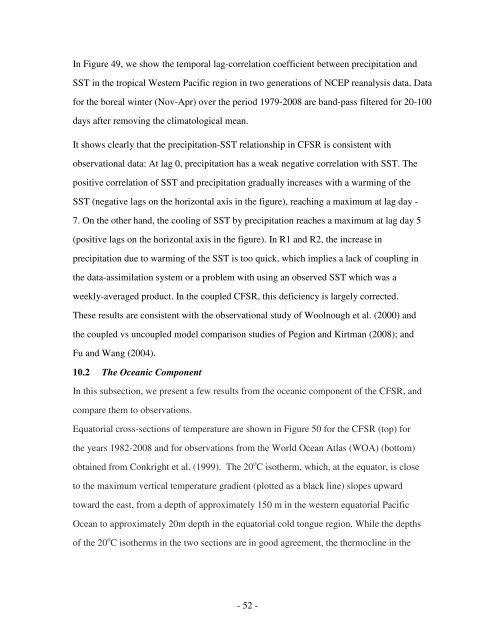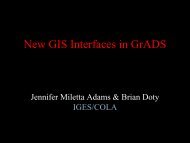The NCEP Climate Forecast System Reanalysis - NOAA National ...
The NCEP Climate Forecast System Reanalysis - NOAA National ...
The NCEP Climate Forecast System Reanalysis - NOAA National ...
Create successful ePaper yourself
Turn your PDF publications into a flip-book with our unique Google optimized e-Paper software.
In Figure 49, we show the temporal lag-correlation coefficient between precipitation andSST in the tropical Western Pacific region in two generations of <strong>NCEP</strong> reanalysis data. Datafor the boreal winter (Nov-Apr) over the period 1979-2008 are band-pass filtered for 20-100days after removing the climatological mean.It shows clearly that the precipitation-SST relationship in CFSR is consistent withobservational data: At lag 0, precipitation has a weak negative correlation with SST. <strong>The</strong>positive correlation of SST and precipitation gradually increases with a warming of theSST (negative lags on the horizontal axis in the figure), reaching a maximum at lag day -7. On the other hand, the cooling of SST by precipitation reaches a maximum at lag day 5(positive lags on the horizontal axis in the figure). In R1 and R2, the increase inprecipitation due to warming of the SST is too quick, which implies a lack of coupling inthe data-assimilation system or a problem with using an observed SST which was aweekly-averaged product. In the coupled CFSR, this deficiency is largely corrected.<strong>The</strong>se results are consistent with the observational study of Woolnough et al. (2000) andthe coupled vs uncoupled model comparison studies of Pegion and Kirtman (2008); andFu and Wang (2004).10.2 <strong>The</strong> Oceanic ComponentIn this subsection, we present a few results from the oceanic component of the CFSR, andcompare them to observations.Equatorial cross-sections of temperature are shown in Figure 50 for the CFSR (top) forthe years 1982-2008 and for observations from the World Ocean Atlas (WOA) (bottom)obtained from Conkright et al. (1999). <strong>The</strong> 20 o C isotherm, which, at the equator, is closeto the maximum vertical temperature gradient (plotted as a black line) slopes upwardtoward the east, from a depth of approximately 150 m in the western equatorial PacificOcean to approximately 20m depth in the equatorial cold tongue region. While the depthsof the 20 o C isotherms in the two sections are in good agreement, the thermocline in the- 52 -





